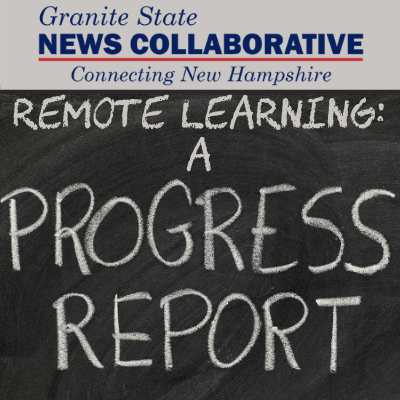As New Hampshire administrators, teachers, parents and students make back to school preparations, the Granite State News Collaborative takes a data-driven deep dive into the remote learning lessons from the spring and how they might inform the future of education in the Granite State.
Schools focus on student’s mental health during remote learning
Teaching her third and fourth grade students at Jennie Blake Elementary School in Hill, New Hampshire, by video conference last spring, teacher Alicia Schaefer spotted a trend.
“I started to notice that some of my really good students are really social, and they were the ones that seemed to have the hardest time,” Schaefer said. Learning remotely, some of her most gregarious students became listless without the chance to interact with their peers in person.
“Even though they were still doing their work, they just didn’t seem like the same students,” Schaefer said.
Access to Technology, Family Communication, Make Remote Learning Difficult for English-Language Learners
English language learners (ELL) — children whose first language isn’t English or whose families primarily speak another language — make up just over 3% of the students in the state, according to 2019-20 estimates used to determine state aid to localities for the cost of providing an adequate education. However, that varies widely from district to district: Manchester has the highest population of ELL students, while some towns have no ELL population. ELL students, sometimes called ESL or ESOL students, attend mainstream classes and complete assignments, but also get additional support from ELL teachers.
Special Needs Students, Parents, Struggled During Remote Learning
Many New Hampshire students and families struggled with the transition to remote learning, but for students with special needs the challenges were especially large. About 17.7% of New Hampshire students have special needs, according to 2019-20 estimates used to determine state aid to localities for the cost of providing an adequate education. That metric covers everything from learning disabilities to autism spectrum disorder, socio-emotional challenges to physical disabilities. Many of these students and their parents faltered with remote learning and some supports — including physical therapy and occupational therapy — couldn’t be delivered at all during distance learning, according to educators who spoke with the Collaborative.
Districts Had Trouble Tracking Student Progress Remotely
The Milton School District, SAU 64, has traditionally struggled with student proficiency on standardized testing. But at the beginning of 2020 Jan Radowicz, principal of Nute Middle High School in Milton, was looking forward to testing. The district had been working hard to address its students' gaps in achievement and Radowicz was confident that scores would show that progress.
From large class sizes to cheating, educators look to improve remote learning instruction
There was still snow on the ground when schools in Lincoln and Woodstock transitioned to remote learning this spring. Students, forced to learn remotely, began spending more time inside and behind a screen. But Aaron Loukes -- whose job it is to make sure Lin-Wood elementary and middle school students are staying active -- saw the pandemic as an opportunity for students to be more creative with their fitness.
Changes in attendance policies obscure challenges faced by schools while tracking students’ learning time
Sunapee Middle-High is a relatively small school -- enrollment 251 -- with enough computers on hand to make sure every student grades 6 and up went home with one when remote learning began last spring. In a parent survey sent out by the district at the end of March, more than 99% of respondents said that their student had access to the technology they needed for remote learning.
But to make sure that teachers were focusing their energy on engaging with students, Moynihan told teachers that the attendance policies would be relaxed. “Typically we’re taking attendance at 8 AM every day,” he said. “But during COVID, we just asked our teachers and students to engage with each other. As long as a student engaged in class at some point during the week, we counted them as present.”
Broadband proves to be an issue as schools across New Hampshire switch to remote learning
Schools Contend With Myriad Challenges of Remote Instruction
In the case of last spring’s quick pivot to remote instruction, schools also had to figure out how to adapt teaching methods for students with special needs, reach English language learners, connect families to technology, track attendance, monitor learning and see to students’ wellbeing — all without seeing them face-to-face.









